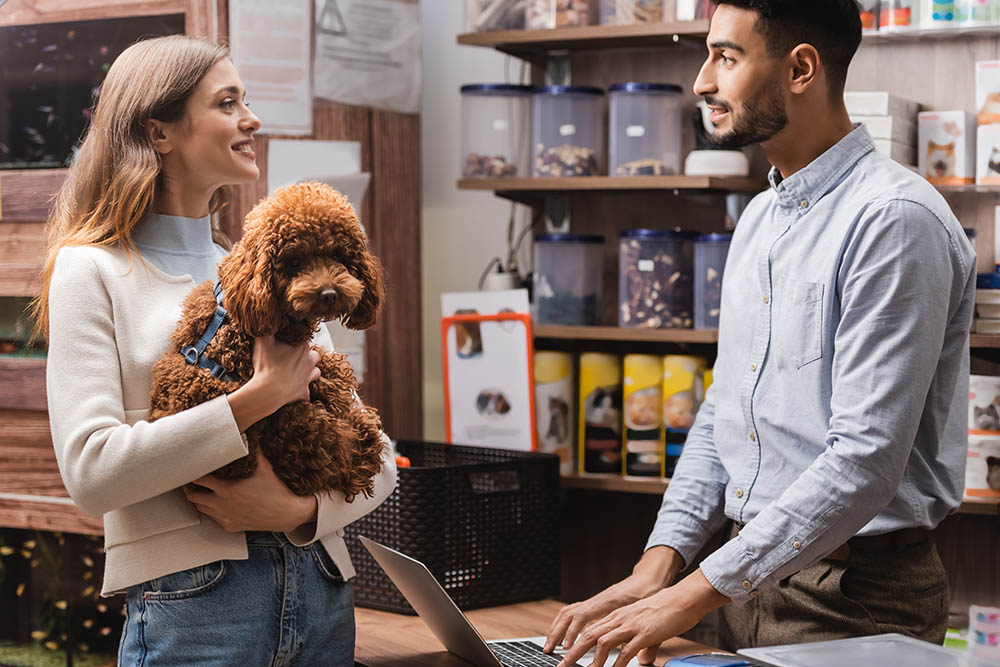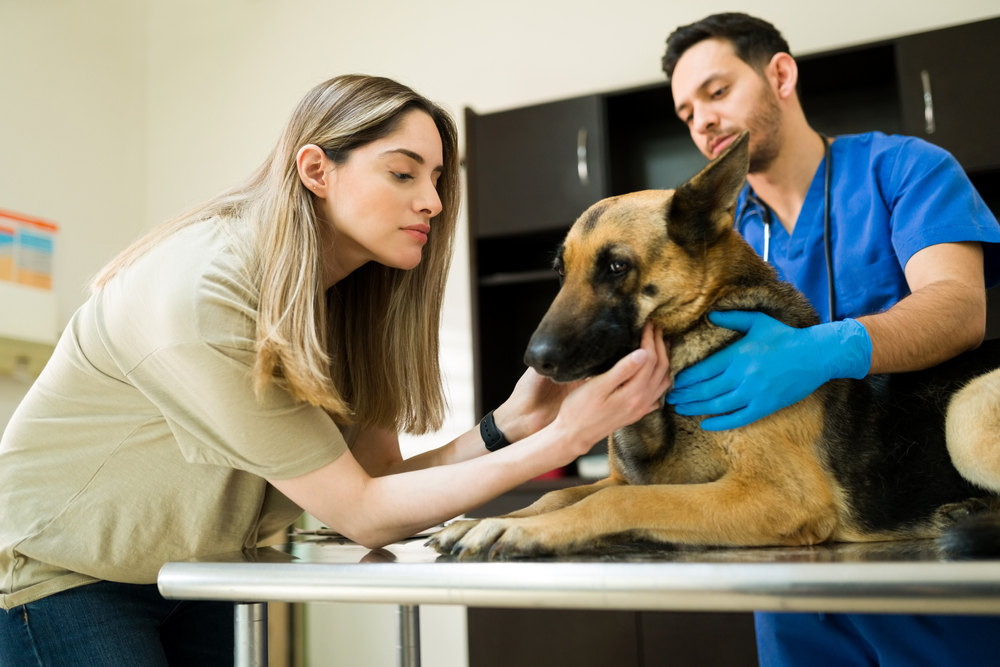In this article
If you live with anyone else, whether it be a partner, roommate, or parent, you know that you have to clear decisions with them. After all, you both are sharing a single space and they really should have a say in what goes on in the household.
Getting a dog might sound really awesome for one person, but another might be incredibly hesitant. There is usually a really good reason for that. Getting a dog is a huge commitment and responsibility for all parties involved.
If you’re really trying to plead your case, we will review some things to touch base on in this article. We’re also going to give you a few realities you might not have considered to see if getting a dog truly is the right move for you.

The 9 Tips to Convince Someone to Get a Dog
1. Explain the Emotional Benefits of Dog Ownership

People rely on their dogs every day to give them emotional support and affection. For some, having a dog isn’t an option—it’s a necessity.
If you think that you and other people in your home could emotionally benefit from having a dog, you could do a little more research about the psychological and emotional benefits of owning a dog.
You might explain that dogs can have the following health benefits:
- They provide stress relief
- They improve self-esteem
- They can help mental health
- They teach unconditional love
- They increase physical activity
- They encourage you to be social
- They decrease loneliness
Who could say no to all of that?
2. Demonstrate Your Preparedness
If you want to convince another person you are ready to have a dog, you better walk the walk. Come with receipts. Be prepared to show that you are completely capable and willing to care for the dog.
Be very straightforward because you know owning a pet is a huge commitment. Agree with them that it takes a lot of hard work and effort, but you’re aware of all of it, and you’re prepared to handle it.
3. Have an Answer for Questions

You’re going to have a lot of questions coming at you if a person is trying to divert you away from getting a dog. You will need to have an explanation for everything they plan to ask. You, of all people, know why they might not want an animal.
So, it’s up to you to use those particular factors and be ready to counteract them. Prepare to have an answer for:
- How you plan to afford vet care
- Who will care for the dog if you’re gone
- Who will assume responsibility
- How it will fit in with everyone’s schedules
- How to navigate around allergy sufferers
You know their hang-ups better than anybody. Try to be prepared for what they’re going to ask and have an answer for it.
4. Acknowledge Potential Roadblocks
There will be certain things said that you can’t argue with. If someone makes a very good point, or you know that you’ve lost the battle, you might want to acknowledge these things instead of just trying to get past them.
The person you’re trying to convince wants to know that you have truly looked at all sides of things, even if you do end up getting your way.
5. Talk About Responsibility

It is important to have a really good conversation about responsibility. Owning a dog is somewhat comparable to raising a child in the sense that they rely on you for everything.
Even though you’re totally ready to take on this responsibility, it doesn’t necessarily mean that other people in your household are willing to do the same. If you want to take care of this dog, you can’t expect others to do so if they haven’t agreed to doing that.
Meaning, if you are still living with your parents and going to school full time, you won’t be there during the day to take the dog out. If your mom or dad doesn’t want to have that responsibility, they can refuse to do it.
Then, you would have to come up with an alternative solution on what to do with your dog while you’re in school.
6. Explain the Importance of a Certain Breed
If you have love for a particular breed, let the person you’re trying to convince know how much you’ve learned about them. Describe all of the benefits of this type of breed and why it would really make a positive impact on your household.
All sorts of breeds are fantastic for a number of reasons. It won’t be hard to pick a couple that really stand out. If you’ve had your eye on a particular dog, don’t be afraid to jot down a few different points on what makes it fabulous.
Really sell it! Make the other person excited to learn. Granted, this won’t work every time, but it does show that you are extremely passionate.
7. Explain the Importance of Adoption

If you want to adopt a dog, you can really get into a bunch of statistics on shelter animals in the entire world. Explain that even in the United States alone, 6.3 million pets enter animal shelters on a yearly basis.
Out of those 6.3 million, only 4.1 are ever adopted out to new homes. Almost 1 million are happily reunited with their owner. Unfortunately, almost 1 million of them are euthanized before they ever find their forever home. In no-kill shelters, certain less adoptable pets can spend months and even years at a shelter without placement.
If you are in a predicament where you can help, you can talk to this person about potentially saving a life and creating a better world at least for that dog.
8. Don’t Commit to a Puppy Without Prior Consent
The last thing you want to do is commit to a puppy, go get the puppy, and then bring it home without ever discussing it with anyone that you live with. This will definitely not go the way you hope. You might think that you’ll be able to coax them into it once they see the adorable face of this little dog, but the opposite is often true.
People can tend to feel very deceived and they might even make you take the dog back. So to avoid any kind of bad feelings on the subject, never fully commit without prior consent.
9. Consider Fostering

If you and the person you’re trying to convince can just not seem to see eye-to-eye on the matter, bring up fostering. Fostering is a great way to invite an animal into your home without a long-term commitment.
Fostering can be a great way to ease everyone into it in a stress-free way. However, during fostering, you might decide that you’re not ready to fully commit to having your own pet.
Or, the person you’re trying to convince might fall in love, then just decide they would love to have a dog in their home. It’s hard to say how certain situations will manifest, but it can be a really good way to get the ball rolling.

The 13 Considerations to Make Before Getting a Dog
It’s easy to try to persuade someone else to want a dog when you’re all hopped up on dopamine, but have you thought about the reality? Have you thought long-term about what it will truly be like to care for a dog for the next 10 to 15 years? Let’s make sure you’ve crossed your T’s and dotted your I’s.
1. Are You Financially Stable?
Taking care of a dog is a huge financial stressor. You might think that a bag of dog food and fresh water really is all you need, but you would be missing some of the other components that go into pet care.
If this is your first time owning a dog or you haven’t really done the math, allow us to explain a few things about how expensive a dog can actually be.

2. Vet Care
Vet care is one of the most cost intensive aspects of pet care as a whole. If you’ve been to the vet lately you may have seen vets, receptionists and vet techs. You may have been offered blood tests, x-ray or ultrasound for diagnosis of your pet’s illness. It should come as no surprise that all of these things cost a lot for the practice to provide in terms of staff, building, insurance and machine costs and that is why a trip to the vet can be expensive. To be able to afford modern day veterinary care, more and more people are turning to pet insurance to cover the cost.
Today, the average cost of a routine veterinary checkup ranges between $25 to $186. Emergency vet care can range from $370 to upwards of $3,000.
Do you have a plan put in place to make sure that your dog gets the vet care they require, despite your financial state? Are you prepared to take your dog to the vet annually, or even more, if they require it?
3. Supplies
Even though most supplies will cost a pretty penny upfront and taper out, it still is a recurring expense any pet owner should anticipate.
Here are some supplies you’ll need:
- Food and water bowls
- Dog beds
- Dog treats
- Food
- Grooming supplies
- Leash/harness
- Poop bags
And the list goes on.

4. Grooming
Not all dogs require grooming, and if you’re an experienced person, you can take care of this at home for free. However, many choose to take their dog to the groomer to either get haircuts or just to freshen up.
If you choose to take your dog to a professional groomer, this can incur greater expense. You can take your pets to a chain or a private groomer, but you’ll still be spending between $30 and $90 per session.
5. Do You Have the Time?
Having a dog is a fun idea in theory, but it also requires a huge amount of commitment in relation to your time. It might not be something you think about at first, but allow us to put it into perspective.
If you are a person over 18 in this economy, you likely already have a job. While you absolutely need your job to make money, it also puts you away from the house. Will anybody be home with the dog during these times? Will you have someone to care for them and let them outside while you’re away? Will they be kenneled most of the time?
Dogs need interaction, training, socialization and exercise on a daily basis. Depending on the breed you could spend an hour to several hours a day meeting your dog’s needs. If you don’t have the time to meet these needs, your dog will be unhappy and can develop behavioral issues like destructive habits, excessive barking, fearfulness, or even aggression.

6. Are You Responsible Enough?
We would all like to think of ourselves as responsible people. But even though we can easily take care of ourselves and make sure all of our bills are paid, that doesn’t necessarily mean that we are responsible enough to care for another life.
Having a dog is a huge commitment, and it will require you to do things you don’t want to do sometimes for the sake of the dog.
7. Do You Understand the Commitment?
When you get a dog, you are automatically committing to taking care of that animal until they’ve crossed the Rainbow Bridge. That can mean taking your dog through moving transitions, welcoming new family members, separations, and the works.
Are you prepared to keep them no matter what?

8. Do You Know About the Breed?
We cannot stress the importance of ensuring a person understands the type of dog breed they’re getting. Often, a huge reason for rehoming or surrendering pets is due to incompatibility.
For example, if you are interested in a dog like a Belgian Malinois, German Shepherd, Brittany Spaniel, or Australian Shepherd, you should be very aware of the amount of exercise and mental stimulation these dogs need.
Often, new owners are taken by surprise when a puppy exhibits extreme chewing and other destructive behaviors because of pent-up energy. They soon realized they just don’t have the time to devote to the amount of exercise that particular breed needs. Therefore, they feel unsuccessful in ownership.
9. Do You Have a Vet?
You’re going to get to know your vet very well. You might want to make sure that there are veterinary services in your area. There is often a huge demand for veterinary care and some clinics have closed their books to new clients. We are all different and as such have different expectations of our health care providers. While we would hope that all showed the same level of compassion and professionalism, there are different strokes for different folks. Do their consulting hours work for you, do they offer hospital services or out of hour care?
Make sure to ask around for recommendations or have a vet in mind before you even get a dog. When you bring home your puppy, it won’t be very long until it’s time for their very first vet appointment.

10. Do You Live in a Dog-Friendly Place?
If you rent or otherwise don’t own your home, you’re going to have to get consent before bringing your dog home.
Make sure to tell your landlord the exact breed you plan to get to ensure there are no breed restrictions. You will also have to get the information about how big they will be as adults to make sure they fit in with any weight restrictions.
11. Can You Commit to Training?
Training is a must if you want a well-behaved dog that can easily coexist in a house with more than one other person. If you don’t feel fully prepared to train a dog yourself, it is important to know who will.
Find a professional trainer in your area with affordable rates that can potentially help you if it comes down to it.

12. Will Your Pup Be Alone Often?
If you know that you’re not going to be home on a regular basis, getting a dog is likely not the best move to make.
Even if you know someone else is going to be home, that means that you would be asking the other person to commit to the same level of care that you, as the owner, are giving them. This may work fine in households where it is a joint pet, but if they are only yours, family members or acquaintances might get sick of doing the work for you.
13. Who Will Care for Your Dog If You’re Away?
We all have to leave our homes from time to time for an extended stay somewhere else. So who is going to watch your dog if you have to leave for a few days? You might not have a lot of available family or friends who can take on the responsibility as everyone works and has conflicting schedules.

Conclusion
Hopefully, you will take this entire article as food for thought. Remember that even if you’re completely ready to have a new dog, others in your home might not be on the same page. You can argue your case all day long, but until they’re ready, it’s not a good idea for it to happen.
After all, you still want your pup’s homecoming to be a joyous one and not one with any resentment on the backend. Best of luck in your argument! Hopefully, you bring home a little fuzzy guy or gal in no time.
See also:
- 11 Vet-Verified Reasons to Get a Dog: Why They Are the Best Pets
- 10 Vet-Reviewed Reasons to Get a Puppy: How it Can Improve Your Life
Featured Image Credit: BearFotos, Shutterstock




















